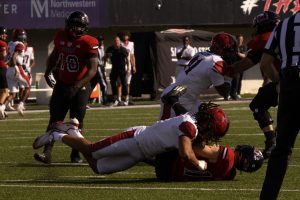Athletic Board changes proposed
April 6, 1987
Changes in NIU’s Athletic Board’s composition might be forthcoming if a recommendation from a board committee is brought to the University Council for approval.
The Ad Hoc Committee on Policy and Structure presented a proposal to the board Wednesday that would reduce the number of voting members from 31 to 15 but increase the non-voting sector from three to five. The end result is a slimming down of the board membership from 34 to 20.
The Athletic Board acts as an advisory to NIU President John LaTourette. The board sets policy for the athletic department by approving items such as schedules and ticket prices as well as asking for reports when problems arise, such as the fielding of teams or the selection of facilities for games. The board also makes suggestions to the department.
Board Chairman Curt Norton said the board is unable to change its composition on its own. Instead, he said the board gives input to the UC, which decides about permanent changes.
Norton said he ordered the committee to compile a report on the board’s composition because the UC expressed concern last year about the board’s size. The final report said the committee was supposed to find out how other Division I universities’ athletic boards were composed and then make a recommendation on how NIU’s board should be arranged.
“The question is: do we need all those people that we have representing the constituency we have?,” said Ray Dembinski, a member of the committee.
The two groups dropping the most in size in the recommendation are faculty and Student Association representatives, which are the largest groups on the board. Faculty representation would be cut in half from 14 to seven, while the SA would be cut from seven to two.
The proposal also recommends the representative from the Huskie Club and NI Club booster organizations be switched from voting to non-voting members. The report states this move extends the rule passed in January at the National Collegiate Athletic Association convention that bans boosters from recruiting.
Dembinski said because the booster organizations have contact with athletic directors Robert Brigham and Susie Pembroke-Jones, they should not be eliminated entirely. Brigham, Pembroke-Jones and Nancy Vedral, NIU’s faculty representative to the NCAA, would retain non-voting status.
Dembinski asked the board Wednesday that, if the board makes a proposal to the UC, he would like the proposal not to become public. Board members decided against the idea.
The proposal also suggests cutting Alumni Association representation from two to one and giving the operating and professional staffs one combined vote instead of one each. The chairman and LaTourette’s representative would stay at one person each. Two athletes—one male and one female—would continue as voting members.
The recommendation also stated that a scheduling committee be formed. This committee would handle listing games contracted for in the long range, review how games might interfere with final exam schedules and how many days of classes athletes would miss for competition, check on balance of home and away games and look into the site of games, according to the recommendation.
At Wednesday’s board meeting, Norton asked for a discussion of possible restructuring. However, he said no motion should be made until the next board meeting April 29.
SA Treasurer Lisa Schlepp said she cannot understand why the UC wants the board to change just because of size. She also said she cannot remember the topic coming up at a UC meeting last year.
“I would say if there is not enough evidence, we should not recommend a change,” she said.
“If the University Council wants us to look like the other people (universities), then this proposal reflects that,” Dembinski said. “I think effectiveness should be more important than mirroring someone else.”
“We tried to stay within the NCAA guidelines for faculty and staff and then started pairing off from there,” said committee member Joe Koch.
SA President Jim Fischer said he was concerned about the major reduction in SA representatives. Todd Kusma, another SA representative, seconded Fischer’s comments and mentioned it was difficult to contact the athletes.
Some board members mentioned one reason the UC might be concerned about the board’s size was a possible problem with having a quorum for the meetings. Board members pointed out attaining a quorum has not been a problem.
Joe Grush, board member from the psychology department, asked the board whether the plan would be phased in.
“That is a legitimate concern,” Norton said. “Any transition procedure would have to be in accordance with that (faculty majority).”
The report was completed by sending out questionnaires to 58 universities, asking about their athletic board’s composition. Some of those universities belonged to athletic conferences such as the Big Ten, the Big Eight and the Athletic Coast Conference, while others are independents in athletics.
The questionnaire asks about the universities’ board members (selection, length of term), the board’s responsibilities, the relation to university personnel, names of board subcommittees and the amount of times the board meets. The questionnaire allows space to determine satisfaction toward these areas.
Of the 27 responses included on the report, faculty represented the largest group on the average, and the responding boards averaged about 13 members.






